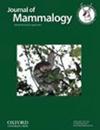A new extinct desert rodent from the Holocene of South America and its bearing on the diversity of Octodontidae (Hystricognathi)
IF 1.5
3区 生物学
Q2 ZOOLOGY
引用次数: 0
Abstract
A Late Holocene (ca. 3,100 to 380 BP) sample of the viscacha rat genus Octomys (Octodontidae) from the Vaquerías Gruta 1 site (VQ-G1) in western Argentina is reported. Phylogenetic and morphometric comparative analyses with living octodontids support that the VQ-G1 sample is related to the desert specialists Tympanoctomys and Octomys, and is sister to the only living species of the latter, O. mimax. The estimated morphological distance to O. mimax is greater than that between pairs of congeneric octodontid species, and even greater than that between some species belonging to different genera. This suggests that the sample represents a new species, whose young age prevents interpreting it as an anagenetic ancestor of O. mimax. If the new species is the result of cladogenesis, its absence in the current fauna represents actual extinction, which among caviomorphs is added to those of †Clyomys riograndensis, †Dicolpomys fossor, †Ctenomys viarapaensis, and †Galea tixiensis—also extinct in the Late Holocene. Thus, the VQ-G1 sample provides evidence of changes in diversity and distribution undergone by small mammals in southern South America during that time. The potential contribution of the Holocene record may be key to elucidate this issue from both an evolutionary and a conservation perspective. This requires a detailed systematic approach to determine whether the taxa under study are truly independent evolutionary units, as well as geographically broad sampling efforts to distinguish the changes affecting distribution from those producing irreversible changes in diversity.南美洲全新世新灭绝的沙漠啮齿动物及其对八齿兽科(Hystricognathi)多样性的影响
报告了来自阿根廷西部 Vaquerías Gruta 1 遗址(VQ-G1)的全新世晚期(约公元前 3100 年至公元前 380 年)糯鼠属 Octomys(八齿目)样本。与现生八齿兽的系统发育和形态比较分析表明,VQ-G1样本与沙漠专科八齿兽Tympanoctomys和Octomys有亲缘关系,并且与后者唯一的现生物种O.mimax 的形态距离大于同属的一对八齿兽之间的距离,甚至大于属于不同属的某些物种之间的距离。这表明该样本代表了一个新物种,由于其年龄较小,无法将其解释为 O. mimax 的祖先。如果该新物种是克隆发生的结果,那么它在当前动物群中的缺失就代表着实际的灭绝,这与 †Clyomys riograndensis、†Dicolpomys fossor、†Ctenomys viarapaensis 和 †Galea tixiensis 一样都是在全新世晚期灭绝的鱼类。因此,VQ-G1样本为南美洲南部小型哺乳动物在这一时期经历的多样性和分布变化提供了证据。全新世记录的潜在贡献可能是从进化和保护角度阐明这一问题的关键。这就需要采用详细的系统方法来确定所研究的类群是否是真正独立的进化单元,同时还需要广泛的地理取样工作,以区分影响分布的变化和造成多样性不可逆转变化的变化。
本文章由计算机程序翻译,如有差异,请以英文原文为准。
求助全文
约1分钟内获得全文
求助全文
来源期刊

Journal of Mammalogy
生物-动物学
CiteScore
3.30
自引率
5.90%
发文量
106
审稿时长
4-8 weeks
期刊介绍:
Papers are published on mammalian behavior, conservation, ecology, genetics, morphology, physiology, and taxonomy.
 求助内容:
求助内容: 应助结果提醒方式:
应助结果提醒方式:


